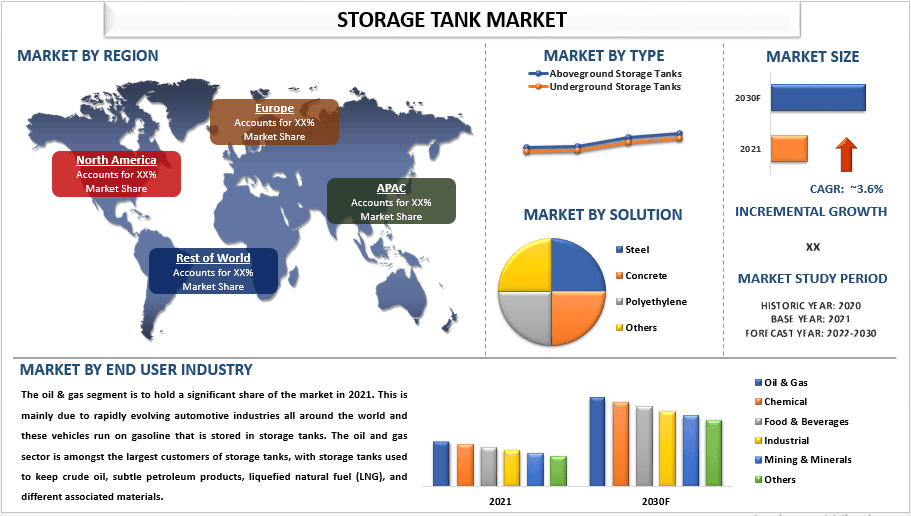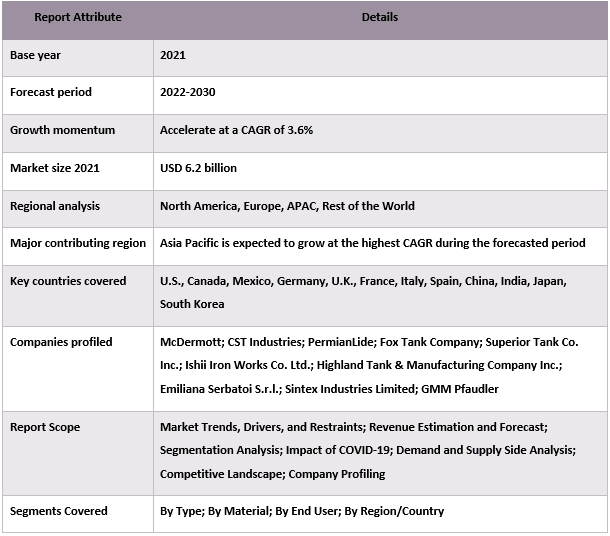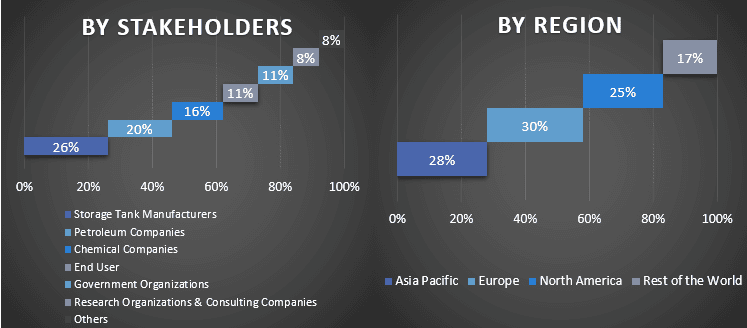
저장 탱크 시장은 전 세계적으로 석유 및 가스 산업이 성장함에 따라 예측 기간 동안 약 XX%의 강력한 연평균 성장률(CAGR)로 성장할 것으로 예상됩니다. 석유 및 가스 산업은 1세기 이상 동안 산업화된 세계의 중추였습니다. 석유 및 가스 산업은 전례 없는 속도로 확장되고 있으며 원유, 천연 가스 및 다양한 석유 제품에 대한 수요가 전 세계적으로 증가하고 있습니다. 수요 증가는 주로 아시아 태평양 지역의 신흥 경제국의 인구 증가와 산업화에 의해 주도되고 있습니다. 따라서 석유 및 가스 산업은 정기적으로 외딴 지역에 있는 새로운 석유 및 가스 공급원을 지속적으로 탐색하고 있으며 추출된 석유 및 가스는 세계 여러 지역으로 운송되어야 합니다. 석유 및 가스 산업의 대량 운송 필요성으로 인해 이러한 제품을 운송하기 전에 일시적으로 저장하는 방법으로 저장 탱크 사용이 증가했습니다. 예를 들어 2023년 5월 India Brand Equity Foundation에서 발표한 보고서에 따르면 원유 소비량은 2022 회계연도의 2억 270만 톤에서 2040 회계연도까지 연평균 성장률 5.14%로 5억 톤으로 증가할 것으로 예상됩니다. 배럴 기준으로 인도의 석유 소비량은 2022 회계연도의 405만 BPD에서 2030년에는 720만 BPD, 2050년에는 920만 BPD로 증가할 것으로 예상됩니다. 천연 가스 소비량은 2021년의 1억 7,400만 MCMPD에서 2030년까지 연평균 성장률 12.2%로 5억 5,000만 MCMPD로 증가할 것으로 예상됩니다. 저장 탱크는 원유 및 천연 가스 생산 채널의 중간 지점 역할을 합니다. 따라서 성장하는 석유 및 가스 산업은 향후 저장 탱크 시장에 대한 수요를 촉진합니다.
시장에서 활동하는 주요 업체로는 McDermott, CST Industries, PermianLide, Fox Tank Company, Superior Tank Co. Inc., Ishii Iron Works Co. Ltd., Highland Tank & Manufacturing Company Inc., Emiliana Serbatoi S.r.l., Sintex Industries Limited 및 GMM Pfaudler가 있습니다. 이러한 업체들은 고객에게 첨단 혁신적인 제품/기술을 제공하기 위해 여러 M&A와 파트너십을 체결했습니다.
보고서에 제시된 통찰력
“유형 중에서 지상 저장 탱크 부문이 2021년에 시장 점유율을 장악했습니다.”
유형에 따라 시장은 지상 저장 탱크와 지하 저장 탱크로 양분됩니다. 지상 저장 탱크 범주는 역사적인 해에 시장을 지배했으며 예측 기간에도 동일한 추세가 예상됩니다. 지상 저장 탱크는 바닥 표면 위에 세울 수 있으며 원통형 또는 정사각형 모양일 수 있는 탱크입니다. 이러한 종류의 탱크는 특히 원유, 휘발유, 디젤 및 기타 석유화학 제품을 저장하기 위해 석유 및 가스 산업 내에서 광범위하게 사용됩니다. 또한 지상 저장 탱크의 설치는 지하 차고 탱크에 비해 덜 복잡합니다. AST를 건설하는 것은 상당히 쉽고 UST와 달리 굴착 작업이 필요하지 않습니다. AST는 검사, 유지 보수 및 수리에 더 쉽게 접근할 수 있습니다. 탱크가 바닥 위에 위치해 있으므로 수리가 필요한 누출, 부식 또는 손상을 쉽게 찾아낼 수 있습니다. 또한 지상 저장 탱크는 UST에 비해 수명이 더 깁니다. AST는 주로 금속으로 제조되고 부식을 방지하는 재료로 덮여 있습니다. 이 코팅은 탱크의 수명을 연장하고 정기적인 유지 보수 및 검사를 통해 수십 년 동안 사용할 수 있습니다.
“재료 중에서 강철이 2021년에 시장의 선두 부문을 차지했습니다.”
재료에 따라 시장은 강철, 콘크리트, 폴리에틸렌 등으로 세분화됩니다. 강철은 현재 선두 부문이며 예측 기간 동안 해당 부문을 지배할 것으로 예상됩니다. 강철을 저장 탱크 시장에서 인기 있게 만드는 요인 중 하나는 비용 효율성입니다. 여기서 금속 저장 탱크의 가격은 다른 재료와 비교할 때 상당히 저렴합니다. 마찬가지로 금속은 유지 관리 및 수리가 용이하여 장기 사용 및 낮은 유지 관리 비용에 이상적인 재료입니다. 예를 들어 금속 저장 탱크는 텍사스주 휴스턴에 있는 Kinder Morgan의 확장된 탱크 저장 시설입니다. 이 프로젝트에는 최대 1,000만 배럴의 원유를 보유할 수 있는 금속 저장 탱크 개발이 포함되었습니다. 이 저장 탱크 프로젝트는 약 25억 달러의 비용으로 완료되었으며 이 시설은 정유 및 석유화학 회사의 중요한 유통 허브 역할을 할 것으로 예상됩니다.
“아시아 태평양이 2021년에 저장 탱크 시장을 지배했습니다.”
아시아 태평양 지역은 급속한 산업화, 인구 증가 및 도시화로 인해 예측 기간에 가장 빠르게 성장하는 지역이 될 것으로 예상됩니다. 아시아 태평양 지역 내 저장 탱크 산업의 붐 뒤에 있는 주요 원인 중 하나는 석유 및 가스 제품에 대한 수요 증가입니다. 이 지역의 경제가 견조한 성장을 경험하면서 에너지 수요가 그에 따라 증가했습니다. 이로 인해 이 지역의 석유 및 휘발유 탐사 및 생산이 급격히 증가했습니다. 결과적으로 추출된 석유 및 휘발유를 보관하기 위한 저장 탱크에 대한 수요가 그에 따라 증가했습니다. 또한 이 지역은 화학 물질 및 석유 화학 제품의 최고의 생산국으로 부상했습니다. 플라스틱, 제약 및 화장품과 같은 산업의 성장으로 화학 물질 및 석유 화학 제품을 저장하기 위한 저장 탱크에 대한 수요도 증가했습니다. 예를 들어 중국은 세계 최대의 화학 물질 소비국이며 전 세계 수요의 40% 이상을 차지합니다. 결과적으로 국가는 저장 탱크 산업에서 상당한 성장을 보였습니다. 아시아 태평양 지역은 제조 분야에서도 광범위한 성장을 보였습니다. 중국 및 인도와 같은 국가가 주요 생산 허브가 되면서 원자재, 완제품 및 상업 폐기물을 보관하기 위한 저장 탱크에 대한 필요성이 증가했습니다. 예를 들어 이 지역의 화학 물질 생산자는 메탄올 및 폴리에틸렌과 같은 원료를 보관하기 위해 대규모 저장 탱크가 필요합니다.
저장 탱크 시장 보고서 범위

이 보고서를 구매해야 하는 이유:
- 이 연구에는 인증된 주요 업계 전문가가 검증한 시장 규모 조정 및 예측 분석이 포함되어 있습니다.
- 이 보고서는 전체 산업 성과에 대한 간략한 개요를 한눈에 제공합니다.
- 이 보고서는 주요 비즈니스 재무, 제품 포트폴리오, 확장 전략 및 최근 개발에 중점을 두고 주요 업계 동료에 대한 심층 분석을 다룹니다.
- 업계에 만연한 동인, 제약, 주요 추세 및 기회에 대한 자세한 조사.
- 이 연구는 다양한 부문에 걸쳐 시장을 포괄적으로 다룹니다.
- 업계에 대한 심층적인 지역 수준 분석.
맞춤화 옵션:
글로벌 저장 탱크 시장은 요구 사항 또는 기타 시장 부문에 따라 추가로 맞춤화할 수 있습니다. 이 외에도 UMI는 귀하가 고유한 비즈니스 요구 사항을 가질 수 있음을 이해하므로 귀하의 요구 사항에 완벽하게 맞는 보고서를 얻기 위해 언제든지 저희에게 연락하십시오.
목차
저장 탱크 시장 분석을 위한 연구 방법론 (2022-2030)
글로벌 저장 탱크 시장의 과거 시장 분석, 현재 시장 추정 및 미래 시장 예측은 전 세계 주요 지역에서 저장 탱크 채택을 생성하고 분석하기 위해 수행된 세 가지 주요 단계였습니다. 과거 시장 수치를 수집하고 현재 시장 규모를 추정하기 위해 광범위한 2차 연구가 수행되었습니다. 둘째, 이러한 통찰력을 검증하기 위해 수많은 조사 결과와 가정이 고려되었습니다. 또한, 글로벌 저장 탱크 시장의 가치 사슬 전반에 걸쳐 업계 전문가와 함께 광범위한 1차 인터뷰도 진행되었습니다. 1차 인터뷰를 통해 시장 수치를 가정하고 검증한 후, 전체 시장 규모를 예측하기 위해 상향식/하향식 접근 방식을 사용했습니다. 그 후, 업계에 관련된 세분 시장 및 하위 세분 시장의 시장 규모를 추정하고 분석하기 위해 시장 세분화 및 데이터 삼각 측량 방법이 채택되었습니다. 자세한 방법론은 아래에 설명되어 있습니다.
과거 시장 규모 분석
1단계: 2차 자료에 대한 심층 연구:
연례 보고서 및 재무 제표, 실적 발표, 보도 자료 등과 같은 회사 내부 자료와 저널, 뉴스 및 기사, 정부 간행물, 경쟁사 간행물, 부문 보고서, 제3자 데이터베이스 및 기타 신뢰할 수 있는 간행물을 포함한 외부 자료를 통해 저장 탱크 시장의 과거 시장 규모를 확보하기 위해 자세한 2차 연구가 수행되었습니다.
2단계: 시장 세분화:
저장 탱크 시장의 과거 시장 규모를 확보한 후, 주요 지역에 대한 다양한 세분 시장 및 하위 세분 시장에 대한 과거 시장 통찰력과 점유율을 수집하기 위해 자세한 2차 분석을 수행했습니다. 주요 세분 시장은 보고서에 유형, 재료 및 최종 사용자로 포함되어 있습니다. 해당 지역에서 테스트 모델의 전반적인 채택을 평가하기 위해 추가 국가 수준 분석이 수행되었습니다.
3단계: 요인 분석:
다양한 세분 시장 및 하위 세분 시장의 과거 시장 규모를 확보한 후, 저장 탱크 시장의 현재 시장 규모를 추정하기 위해 자세한 요인 분석을 수행했습니다. 또한 저장 탱크 시장의 유형, 재료 및 최종 사용자와 같은 종속 변수와 독립 변수를 사용하여 요인 분석을 수행했습니다. 전 세계 저장 탱크 시장 부문에서 최고의 파트너십, 합병 및 인수, 사업 확장 및 제품 출시를 고려하여 수요 및 공급 측면 시나리오에 대한 철저한 분석이 수행되었습니다.
현재 시장 규모 추정 및 예측
현재 시장 규모 산정: 위의 3단계에서 얻은 실행 가능한 통찰력을 바탕으로 글로벌 저장 탱크 시장의 현재 시장 규모, 주요 업체 및 세분 시장의 시장 점유율을 도출했습니다. 필요한 모든 백분율 점유율 분할 및 시장 세분화는 위에서 언급한 2차 접근 방식을 사용하여 결정되었으며 1차 인터뷰를 통해 확인되었습니다.
추정 및 예측: 시장 추정 및 예측을 위해 이해 관계자가 사용할 수 있는 동인 및 추세, 제약 및 기회를 포함한 다양한 요인에 가중치가 할당되었습니다. 이러한 요인을 분석한 후 관련 예측 기술, 즉 상향식/하향식 접근 방식을 적용하여 전 세계 주요 시장에서 다양한 세분 시장 및 하위 세분 시장에 대한 2030년 시장 예측에 도달했습니다. 시장 규모를 추정하기 위해 채택된 연구 방법론은 다음을 포함합니다.
- 수익(USD) 측면에서 업계의 시장 규모와 국내 주요 시장에서 저장 탱크 시장의 채택률
- 시장 세분 시장 및 하위 세분 시장의 모든 백분율 점유율, 분할 및 세분화
- 제공되는 제품 측면에서 글로벌 저장 탱크 시장의 주요 업체. 또한 빠르게 성장하는 시장에서 경쟁하기 위해 이러한 업체가 채택한 성장 전략
시장 규모 및 점유율 검증
1차 연구: 주요 지역 전반에 걸쳐 최고 경영진(CXO/VP, 영업 책임자, 마케팅 책임자, 운영 책임자, 지역 책임자, 국가 책임자 등)을 포함한 주요 오피니언 리더(KOL)와 심층 인터뷰를 진행했습니다. 그런 다음 1차 연구 결과를 요약하고 통계 분석을 수행하여 명시된 가설을 입증했습니다. 1차 연구의 입력은 2차 결과와 통합되어 정보를 실행 가능한 통찰력으로 전환했습니다.
다양한 지역의 1차 참가자 분할

시장 엔지니어링
데이터 삼각 측량 기술은 전체 시장 추정을 완료하고 글로벌 저장 탱크 시장의 각 세분 시장 및 하위 세분 시장에 대한 정확한 통계 수치를 도출하는 데 사용되었습니다. 데이터는 솔루션, 애플리케이션 및 최종 사용자 영역에서 다양한 매개변수와 추세를 연구한 후 여러 세분 시장 및 하위 세분 시장으로 분할되었습니다.
글로벌 저장 탱크 시장 연구의 주요 목표
글로벌 저장 탱크 시장의 현재 및 미래 시장 동향은 연구에서 정확히 지적되었습니다. 투자자는 연구에서 수행된 질적 및 양적 분석을 기반으로 투자에 대한 재량을 기반으로 하는 전략적 통찰력을 얻을 수 있습니다. 현재 및 미래 시장 동향은 지역 수준에서 시장의 전반적인 매력도를 결정하여 산업 참가자가 미개척 시장을 활용하여 선점자 이점을 누릴 수 있는 플랫폼을 제공했습니다. 연구의 다른 양적 목표는 다음과 같습니다.
- 가치(USD) 측면에서 저장 탱크 시장의 현재 및 예측 시장 규모를 분석합니다. 또한 다양한 세분 시장 및 하위 세분 시장의 현재 및 예측 시장 규모를 분석합니다.
- 연구의 세분 시장에는 유형, 재료 및 최종 사용자 영역이 포함됩니다.
- 저장 탱크 산업에 대한 규제 프레임워크를 정의하고 분석합니다.
- 다양한 중개인의 존재와 관련된 가치 사슬을 분석하고 산업의 고객 및 경쟁사 행동을 분석합니다.
- 주요 지역에 대한 저장 탱크 시장의 현재 및 예측 시장 규모를 분석합니다.
- 보고서에서 연구된 지역의 주요 국가에는 아시아 태평양, 유럽, 북미 및 기타 지역이 포함됩니다.
- 저장 탱크 시장의 회사 프로필과 빠르게 성장하는 시장에서 지속하기 위해 시장 플레이어가 채택한 성장 전략
- 업계에 대한 심층적인 지역 수준 분석
관련 보고서
이 상품을 구매한 고객님들도 함께 구매하신 상품










